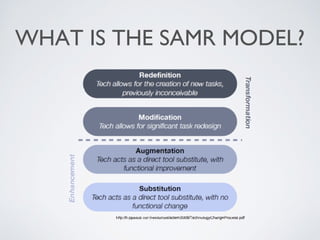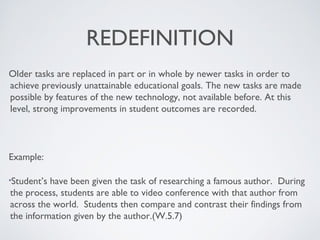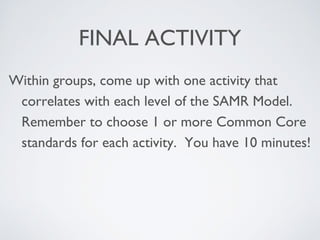The SAMR Model
- 2. WHAT IS THE SAMR MODEL?
- 3. SUBSTITUTION The new technology is used as a direct substitute for an older tool, with no change in the tasks undertaken by students, or how these tasks are accomplished using the new toolset. At this level, no noticeable improvements in student outcomes are recorded. Examples: Typing a paper instead of writing it Working mathematical equations on the interactive whiteboard instead of a standard whiteboard
- 4. AUGMENTATION The new technology substitutes for an older tool, with no change in the tasks undertaken by students. However, features of the new technology are used to improve how these tasks are carried out by students, e.g., by making the tasks easier or faster to accomplish, or by providing additional features not previously available. At this level, small improvements in student outcomes are recorded. Example: Students use the Internet to look up the facts and details about nonfiction text (ELA 4.1b)
- 5. MODIFICATION The tasks to be undertaken by students are significantly redesigned in order to achieve new educational goals. The redesign is made possible by features of the new technology, not available before. At this level, noticeable improvements in student outcomes are recorded. Example: Students conduct a research project where they use several sources to create an informative video. Students then create a separate reflection video about what they learned from the project. (W.5.7, W.5.9)
- 6. REDEFINITION Older tasks are replaced in part or in whole by newer tasks in order to achieve previously unattainable educational goals. The new tasks are made possible by features of the new technology, not available before. At this level, strong improvements in student outcomes are recorded. Example: StudentĄŊs have been given the task of researching a famous author. During the process, students are able to video conference with that author from across the world. Students then compare and contrast their findings from the information given by the author.(W.5.7)
- 7. WHAT LEVEL IS IT? ? Students complete an online worksheet. They then print the worksheet and pass it around. Substitution
- 8. WHAT LEVEL IS IT? ? Students record videos explaining how characters respond to major events and challenges. They take those explanations and share them via the Internet to another class in England. The class in England also shares their student videos with the class. Redefinition
- 9. WHAT LEVEL IS IT? ? Students from different classrooms are asked to each read one variation of Hanzel and Gretel. The first variation is from Germany and the other is from Canada. Students then video chat with the other classroom and explain their version of the story. While explaining the story, the other class is recording differences they see in their version of the story. Augmentation Common Core Standard: RL.2.2, RL. 2.9
- 10. WHAT LEVEL IS IT? ? Students take a quiz using a Google Form instead of using pencil and paper. The grades are recorded in a spreadsheet for easy grading. Augmentation
- 11. WHAT LEVEL IS IT? ? Students are asked to type a paragraph around a specific theme. Students make an audio recording of their paragraph and add music to express emotion. The recording is posted to the school website for parents to review. Modification
- 12. GROUP ACTIVITY ? What could have made the previous example redefinition? Take 5 minutes and discuss it at your individual tables.
- 13. FINAL ACTIVITY Within groups, come up with one activity that correlates with each level of the SAMR Model. Remember to choose 1 or more Common Core standards for each activity. You have 10 minutes!
- 14. Ą°Technology is just a tool. In terms of getting kids working together and motivating them, the teacher is the most important.Ąą ĻCBill Gates














